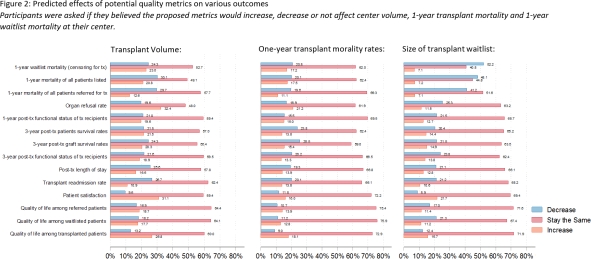Transplant Community Perceptions of the Benefits and Drawbacks of Alternative Quality Metrics for Regulation
JHU, Baltimore.
Meeting: 2018 American Transplant Congress
Abstract number: 575
Keywords: Public policy
Session Information
Session Name: Concurrent Session: Non-Organ Specific: Economics, Public Policy, Allocation, Ethics - 3
Session Type: Concurrent Session
Date: Tuesday, June 5, 2018
Session Time: 4:30pm-6:00pm
 Presentation Time: 5:18pm-5:30pm
Presentation Time: 5:18pm-5:30pm
Location: Room 4C-4
Background: Quality metrics are used to regulate transplant centers, inform patients, and improve quality of care. Currently graft and patient survival are used to regulate transplant programs. However, it is unclear that these metrics contain optimal incentives for transplant quality and volume.
Methods: We surveyed members of the ASTS and AST (n=270) to characterize perceptions about transplant quality metrics. Participants rated alternative metrics on effectiveness for measuring quality of care, amenability to risk adjustment, and predicted effects on volume, 1-year transplant mortality, and waitlist mortality.
Results: Respondents rated 1-year patient survival as both the most effective at measuring quality of care (mean score=7.44 on a 10-point scale) and most amenable to risk adjustment (mean score=6.26, Figure 1). Patient satisfaction was rated least effective at measuring quality of care (mean score=3.38) and evaluated patient mortality rate was rated least amenable to risk adjustment (mean score=4.45).
Over half of respondents (52.5%) believed using 1-year waitlist mortality would decrease 1-year waitlist mortality; however 24.3% of respondents also believed this metric would decrease center volume (Figure 2). A quarter of respondents (25.5%) believed using 3-year post-transplant graft survival would decrease 1-year transplant mortality, while 24.3% believed this metric would decrease center volume. About one third of respondents (32.4%) believed using organ refusal rate would increase center volume, while 21.2% of respondents believed this metric would increase 1-year transplant mortality.
Discussion: Choice of transplant regulatory metrics involve tradeoffs between incentivizing waitlist and post-transplant outcomes. However, many members of the transplant community believe that alternative metrics will not impact quality or volume.
CITATION INFORMATION: Rasmussen S., Zhou S., Thomas A., Segev D., Hersch Nicholas L. Transplant Community Perceptions of the Benefits and Drawbacks of Alternative Quality Metrics for Regulation Am J Transplant. 2017;17 (suppl 3).
To cite this abstract in AMA style:
Rasmussen S, Zhou S, Thomas A, Segev D, Nicholas LHersch. Transplant Community Perceptions of the Benefits and Drawbacks of Alternative Quality Metrics for Regulation [abstract]. https://atcmeetingabstracts.com/abstract/transplant-community-perceptions-of-the-benefits-and-drawbacks-of-alternative-quality-metrics-for-regulation/. Accessed December 21, 2025.« Back to 2018 American Transplant Congress


